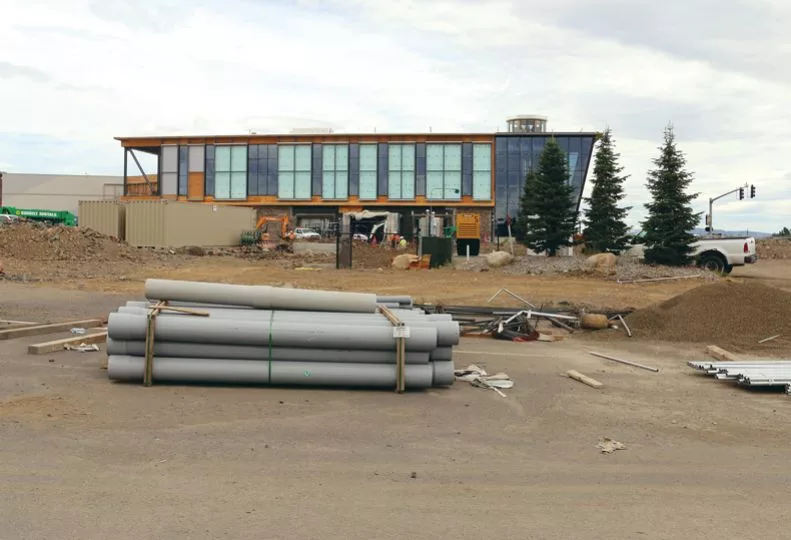Building material prices surge
Costs jump by double digits for lumber, aluminum, other construction supplies

With building material costs rising nationally, Inland Northwest construction companies are feeling the impacts.
The U.S. Bureau of Labor Statistics producer price index for construction materials increased 2.2 percent from April to May, marking the largest monthly price increase since May 2008, according to a press release from the Associated Builders and Contractors.
Similarly, a press release from Associated General Contractors of America says those price index figures rose 8.8 percent from May 2017 to May 2018—the steepest price increase since July 2011.
Vince Campanella, vice president of Spokane Valley-based Lydig Construction Inc., says the company has seen costs climb for a variety of construction materials, including aluminum, concrete, oil, and steel.
Campanella says those cost increases could be attributed to a number of factors, such as the time of year, supply and demand, the strength of the economy, tariffs, and tariff fears.
Rising prices are "a little bit common for this time of year … but I also think we're seeing the result of a vibrant economy right now," he says. "Everybody is busy. Every contractor is busy. There's probably more projects out right now than there is construction capacity."
As demand goes up, "the cost of the product goes up as well. That's certainly putting pressure on pricing these days," he says.
According to the AGC, diesel fuel rose 44.5 percent during the 12-month period ending in May.
Milled aluminum supplies increased 17.3 percent during the same time period. Lumber and plywood jumped 13.9 percent, and milled copper and brass mill materials climbed 13.8 percent, according to AGC figures.
Steel and aluminum tariffs imposed on imports from Canada, Mexico, and the European Union aren't reflected in those price rises, according to the AGC. However, the price increases could reflect trade war fears, the organization says.
John Mandere, president of Rathdrum-based Mandere Construction Inc. and Northwest Building Components Inc., says the price jumps for lumber have affected both companies.
He says material cost increases have been climbing for about 18 months, but they really started jumping in the past five months or so.
Mandere Construction is a framing subcontractor, he says. The 26-year-old company employs about 130 people and focuses on business within the greater Inland Northwest.
Northwest Building Components is a wood truss manufacturer that makes wood floor and roof components for sale to homeowners and homebuilders, he says.
Price increases have made it difficult for both companies "to hold to a quote," he says.
"We used to be able to guarantee a bid for 30 days," he says. "Now, we put about a five- to seven-day window on how long our quotes are good for because material prices are moving so
erratically."
Campanella says material constraints have reduced the time Lydig can maintain a price quote as well. Additionally, many construction supplies have longer lead times than in the past.
"Just trying to put a price on things has been a little difficult just because there's been so much volatility in the past 60 to 90 days," he says.
Campanella says the company manages to incorporate longer lead times into its overall quote, and that Lydig hasn't been "hit too bad so far."
"For projects that are coming, we're certainly letting owners know that we need to make decisions very quickly," he says.
Mandere says his two companies have dealt with longer lead times as well.
He says some materials routinely had been scheduled to be available in three to four weeks now arrive in five to six weeks, and materials that routinely had arrived in five or six weeks now arrive a couple weeks behind schedule, too.
"It's forcing both companies to forecast much further in advance," he says.
Still, rising construction costs might be less concerning to other builders.
Corey Condron, owner of Spokane-based Condron Homes LLC, says lumber prices have jumped significantly, but he hasn't really seen any out-of-the-ordinary price spikes.
Lumber is "up higher than we'd like to see it, and it's up higher than in previous years, but it's done that historically as well, so it's not out of the ordinary for lumber to do that," he says.
Condron Homes has built roughly 2,500 houses since Condron joined the company in 1994, he says. He purchased Condron Homes from his father, Craig, in 2008.
He says Condron Homes anticipated the lumber price increases.
"We built those price increases into our contracts this spring, so it did raise the price of the houses," he says.
For a $500,000 house built by Condron, about $5,000, or 1 percent, of that price resulted from anticipated increases in lumber costs.
In the last 14 months, Condron Homes' average home price has increased by about $30,000, says Condron. However, he says about $25,000 of that jump stems from workforce shortages and a roughly 15 percent wage increase per employee.
Mandere says the price increases can't last forever.
"I personally think it can't survive," he says.
Overall project bid prices aren't being met, he asserts, and it's becoming cost prohibitive.
Campanella says there may be some false inflation due to people reacting to potential tariffs. That could fade in the future.
"We just don't know when that's going to happen. It's an ongoing thing," he says.
Campanella says that market conditions in the Spokane and Coeur d'Alene-area might stay the same for some time.
The local market could remain strong for the foreseeable future, however, he says, pointing out that a number of projects are in the works here, such as planned, multimillion-dollar school projects, which could maintain strong local construction momentum.
Related Articles
Related Products

_c.webp?t=1763626051)
_web.webp?t=1764835652)

